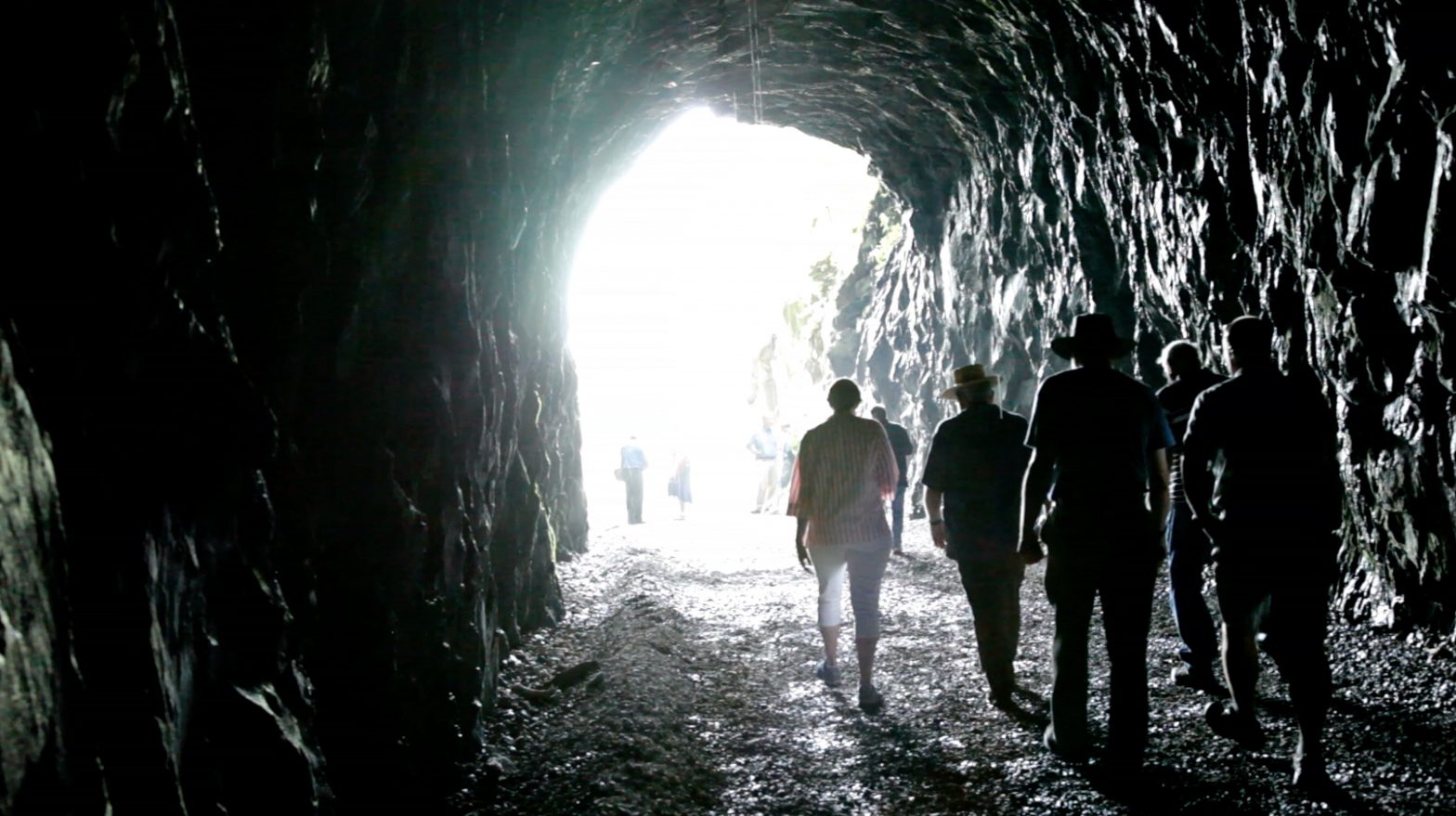By Lisa Provence
Nothing happens quickly with the Claudius Crozet Blue Ridge Tunnel. Not its mid-19th-century eight-year construction, nor Nelson County’s nearly 20-year effort to reopen it, nor the documentary recently released by local filmmakers Paul Wagner and Ellen Casey Wagner.
“I thought it would only be a few years, weaving the reopening and the history of the tunnel,” says Academy Award-winner Paul Wagner, who directed The Tunnel. “I had no idea it was going to take almost nine years.”
When it opened in 1858, the hand-dug Blue Ridge Tunnel was the longest tunnel in North America. About 800 Irish immigrants used star drills and black powder in those pre-dynamite days to carve through Rockfish Gap’s granite, dangerous work that, along with cholera, killed dozens and maimed many more.
The idea of intercutting the two stories—the difficult construction of the tunnel and the nearly two-decade effort to reopen it—appealed to Wagner, who describes the film as “the creation and re-creation of the Blue Ridge Tunnel.”
Says Wagner, “We’ve made a lot of historical films, and often there are not visual materials to tell those stories. It was nice in this case to have a present-day story that was directly related to the historical story, that gave a story thread in the present that reverberated against the historical story line.”
The film focuses on the Irish laborers who fled the famine in Ireland to find work and who were considered more expendable than enslaved workers. This isn’t the Wagners first Irish-centric film. Out of Ireland traced eight workers in the United States, one of whom worked on the railroad.
The Irish in America “have been an interest of ours,” says Wagner, and The Tunnel, which became available on YouTube on St. Patrick’s Day, uses students from the Blue Ridge Irish Music School to help tell the story with music and dancing—and a haunting violin solo.
The Tunnel also tells the story of the enslaved workers and the institution of slavery “in such a powerful way,” says Wagner.
Engineer Claudius Crozet, who was hired to construct a 17-mile railroad from Mechum’s River in Albemarle to Waynesboro, wrote to his board to explain having to pay $2,400 compensation for the deaths of two Black workers. The enslaved laborers contracted out to Crozet could not be used for the black powder blasting, not out of concern for the men but because of their value as property.
“It was an insight on the thinking of the institution of slavery and how it worked,” says Wagner.
Filming provided some challenges. The eastern portal had waist-high water. “We’re vaguely outdoorsy, but I do not have hip boots in my closet,” says Wagner. “I’d wade into water up to the waist in the dark holding a camera.”
Despite that discomfort, Wagner says it was not an arduous shoot. “One of the joys was that you could just walk in there and turn your camera on and end up with these beautiful images,” he says. “Between the light and the dark, the water, the brick walls, the stone, and especially the lighting as you walk in and out of the tunnel. The lighting effects are so beautiful without even trying.”
During the 1950s, a 12-foot-thick bulkhead was built in the tunnel for propane storage, and blocked passage through until restoration work began in 2018. Wagner describes the magic of seeing the light at the other end of the tunnel after it was blasted out.
“I had been in there many times and never seen light,” he says. He compares the experience to December 29, 1856, when workers broke through the rock. A newspaper clipping said, “Light now shines through the Blue Ridge.”
“This is what it was like,” says Wagner. “I had a little emotional reaction.”
The image of a tunnel is symbolic in itself and often mentioned in near-death experiences, he says. “There’s something powerful, almost spiritual about the tunnel.”
Along with the history, it’s also a great local story, one that ties into the rails-to-trails movement, tourism, and recreation, and intersects with the Appalachian Trail and the Route 76 bike trail, says Wagner. “Go with your kids, ride your bike, but there is a real dark and tragic side of the story that’s worth remembering.”
The film was a labor of love for the Wagners. “We didn’t raise a lot of money to do it,” he says. “We did it as a side project over the years,” ultimately getting some funding from the Claudius Crozet Blue Ridge Tunnel Foundation, the Virginia Tourism Corporation, and Virginia Humanities.
“We want as many people as possible to see it,” he says. Historical preservation isn’t just about places like Monticello or Montpelier, adds Wagner. “This is about historic preservation, too. It’s the common people. It’s landscapes—natural and manmade—that are also valid to think about as historic sites.”
Since the Blue Ridge Tunnel opened in November, 35,000 people have gone through it, according to former Nelson County supervisor Allen Hale.
“I think the film really captured the spirit of the project and paid tribute to the people who built it,” says Hale. “It was a lost treasure. The film does a wonderful job of re-claiming this lost treasure.”

